| Pages:
1
2
3
4 |
ScienceHideout
Hazard to Others
  
Posts: 391
Registered: 12-3-2011
Location: In the Source
Member Is Offline
Mood: High Spin
|
|
Quote: Originally posted by Magpie  | | I reported the results of my "activity" testing with methanol per Dr Bob, and with propane. Do you agree that this indicates that my 5%Pd/C has low
or no activity? If not, what test would you recommend? |
Hmmm, as far as 'activity' is concerned, I have never personally tested for catalytic activity. Usually, if we can't get our O-debenzylations to work
after several attempts, we will just write "DEAD" on the bottle and buy a new one! There's a lot of ways a catalyst can go bad, but the fact that you
saw some type of product in your reaction makes me think that your catalyst is probably still good despite the results of your other test.
hey, if you are reading this, I can't U2U, but you are always welcome to send me an email!
|
|
|
Magpie
lab constructor
    
Posts: 5939
Registered: 1-11-2003
Location: USA
Member Is Offline
Mood: Chemistry: the subtle science.
|
|
I'm ready and willing to try another synthesis of succinic acid from maleic anhydride. But I don't want to go to that considerable effort until I can
feel confident about my catalyst activity.
The single most important condition for a successful synthesis is good mixing - Nicodem
|
|
|
ScienceHideout
Hazard to Others
  
Posts: 391
Registered: 12-3-2011
Location: In the Source
Member Is Offline
Mood: High Spin
|
|
Magpie- Have you tried doing different 'types' of hydrogenations with your catalyst to test it? Such as O-benzyl deprotection, or nitro-reduction?
hey, if you are reading this, I can't U2U, but you are always welcome to send me an email!
|
|
|
Magpie
lab constructor
    
Posts: 5939
Registered: 1-11-2003
Location: USA
Member Is Offline
Mood: Chemistry: the subtle science.
|
|
No, I have tried no other hydrogenation.
The single most important condition for a successful synthesis is good mixing - Nicodem
|
|
|
Magpie
lab constructor
    
Posts: 5939
Registered: 1-11-2003
Location: USA
Member Is Offline
Mood: Chemistry: the subtle science.
|
|
I am going to have to eat those words.
Today when I was preparing a balloon full of H2 I got a whiff of H2S. So I tested the gas with lead acetate paper and bubbled the H2 through a lead
acetate solution. The results are shown below with plain water in the middle.
I've been making my H2 by reacting mossy Zn with 6M H2SO4. My Zn is lab grade (Al-Chymist) but I have no specs (analysis) for it. My sulfuric acid
is diluted Rooto drain cleaner. I can try using muriatic acid instead of the sulfuric acid and see if the H2S goes away. If not, I will try
generating my H2 electrolytically.
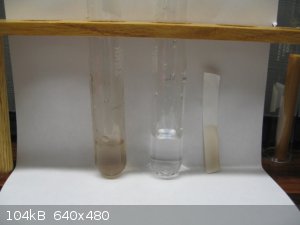
BTW, I have been using a $10 aquarium pump to fill the balloon with H2. It works quite well.
Edit: On 2nd thought HCl would be too volatile.
[Edited on 22-10-2016 by Magpie]
The single most important condition for a successful synthesis is good mixing - Nicodem
|
|
|
Cryolite.
Hazard to Others
  
Posts: 269
Registered: 28-6-2016
Location: CA
Member Is Offline
Mood: No Mood
|
|
Could you try ammonium formate or sodium formate as a hydrogen source? I don't think you could have any sulfur in there!
I just noticed that the entry for chemcenter palladium on carbon on Amazon is unreduced. Might this have prevented the catalyst from igniting
methanol?
[Edited on 22-10-2016 by Cryolite.]
|
|
|
cubalibre
Harmless

Posts: 11
Registered: 3-10-2016
Member Is Offline
Mood: H2 saturated
|
|
Quote: Originally posted by Magpie  |
I am going to have to eat those words.
Today when I was preparing a balloon full of H2 I got a whiff of H2S.
[Edited on 22-10-2016 by Magpie] |
Very glad you tested it!
It's your zinc I am pretty certain. I've used very high quality zinc (allegedly 99,99+%) and still smelled it with HCl (synth qual).
Maybe QC isn't done by some suppliers.
Looking forward to see your electrolysis setup!
[Edited on 22-10-2016 by cubalibre]
|
|
|
Magpie
lab constructor
    
Posts: 5939
Registered: 1-11-2003
Location: USA
Member Is Offline
Mood: Chemistry: the subtle science.
|
|
Quote: Originally posted by Cryolite  | Could you try ammonium formate or sodium formate as a hydrogen source? I don't think you could have any sulfur in there!
|
My goal is to develop catalytic hydrogenation for home chemistry.
Quote: Originally posted by Cryolite.  |
I just noticed that the entry for chemcenter palladium on carbon on Amazon is unreduced. Might this have prevented the catalyst from igniting
methanol?
|
I don't know that much about it. Fleaker suggested that the Pd/C should be reduced with H2. I was getting ready to do this when I discovered the
H2S.
The single most important condition for a successful synthesis is good mixing - Nicodem
|
|
|
Magpie
lab constructor
    
Posts: 5939
Registered: 1-11-2003
Location: USA
Member Is Offline
Mood: Chemistry: the subtle science.
|
|
Not knowing whether the H2S contamination was coming from the Rooto 6M H2SO4 or the mossy Zn, I did some test tube tests this morning. I placed some
metal, ie, either mossy Zn or a part of a Zn electrical fitting, in either Rooto 6M H2SO4 or 6 M muriatic acid using 4 small test tubes. I then
placed a strip of lead (II) acetate paper on top of the test tubes during gas generation. Here are the results:
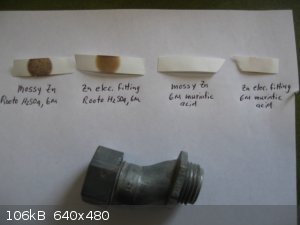
So, it looks like the Rooto 6M H2SO4 is the culprit. I don't know if there is sulfide in the acid or it is a reduction product of sulfate or hydrogen
sulfate.
I was surprised to see some slight evidence from the electrical Zn with muriatic acid. The ASTM B86 specs I've seen for electrical casting zinc
indicate no sulfur present.
The single most important condition for a successful synthesis is good mixing - Nicodem
|
|
|
AvBaeyer
National Hazard
   
Posts: 644
Registered: 25-2-2014
Location: CA
Member Is Offline
Mood: No Mood
|
|
Magpie,
I have been following your travails with the catalytic hydrogenation problem. Your tracking down of the likely source of the sulfurous catalyst poison
is quite interesting. Further, I appreciate your aim to develop a hydrogenation method suitable for the home lab environment. As you more than likely
appreciate, catalytic hydrogenation is one of the most useful and generally one of the cleanest reactions in organic synthesis. However, after
considerable though and musing on your objective, I wonder if you will be truly successful. I do not intend to rain on your efforts or give you all
kinds of bogus theoretical blather about why you will fail. The foremost problem I see is being able to develop proper and safe equipment in a home
lab setting to carry out catalytic hydrogenation.
I have run and supervised hundreds of catalytic hydrogenations in my career. This goes from very small scale reactions under a balloon to pilot plant
runs in a 50 gal reactor under high pressure. Safety considerations in the use of hydrogen gas are paramount. Because of sloppy or
untrained/untrainable chemists frequent issues with poor technique in filtering catalysts as well as improperly stored waste catalyst there are
sometimes laboratory fires. I do not know how many times a wastebasket has inflamed because some idiot dumped a filtered catalyst into it. In the
industrial setting this has led to the general banning of bench top hydrogenations using balloons or other methods as well as the establishment of
spaces especially designed for the handling of hydrogen, reaction work-up and the waste products from those reactions ( ie spent catalyst).
One of the main problems one has to be concerned about with the use of hydrogen gas in a home lab setting is the possibility of forming explosive
mixtures. Keep in mind that hydrogen does not "burn" - it explodes. During reaction set-up and work up, the danger is ignition at the interface
between catalyst, solvent vapor, air, and hydrogen. If one is running a hydrogenation and venting gas into the atmosphere (which is what you did in
your initial experiment), there exists the possibility of explosion initiated by any number of ignition sources in the home lab area unless the
reaction is being run out of doors. Moreover, if one is blowing hydrogen through a volatile solvent such as methanol then a mixture of highly
flammable/explosive gases is being formed outside the reaction vessel.
Much of the safety concern around the use of hydrogen gas can be alleviated by using catalytic transfer hydrogenation which is a well established
technique. Unfortunately, the reaction is often not as clean as a true hydrogenation. Others have already mentioned this technique above so I won't go
any further.
If hydrogen is the reagent of choice then the reduction ideally needs to be run in a closed system (with pressure relief for safety, of course).
Obviously, the best source of hydrogen for this is a cylinder of the gas with the proper pressure reducing valve and suitable gas handling plumbing
including vacuum evacuation and inert gas lines. If self generation of hydrogen is the method of choice, the best source of hydrogen is sodium
borohydride. Hydrogen is about 10% by weight of NaBH4 and which makes it a very concentrated source of the gas.
A number of years ago HC Brown and his students devised a very versatile lab scale hydrogenation apparatus which uses internally generated hydrogen.
This particular apparatus essentially turned hydrogenation into a simple titration. Hydrogen was generated by adding an aqueous solution of sodium
borohydride to a solution of HCl or acetic acid. One could follow the progress of the reaction by the amount of borohydride solution consumed. I have
attached the references in which this apparatus is described. A somewhat more detailed step-by-step description of the set up and its operation can be
found in the 5th Edition of Vogel which is available for free download at:
(https://archive.org/details/TextbookOfPracticalOrganicChemis...)
The Brown apparatus is in my opinion the most ideal set up for the home lab. Its use, however, does not preclude the acute attention to safety which
is paramount in any reduction where hydrogen from any source is being used and ultimately vented.
Sodium borohydride is not often easily available and can be appear expensive on a simple weight basis. Besides its high hydrogen content, NaBH4 is
one of the most versatile of chemical reducing agents and, in my opinion, should be in every chemist's cupboard. It can be induced to reduce many
functional groups and replace in many cases the use of catalytic hydrogenation. The downside can be more laborious reaction work ups but the plus side
is a more safe reaction system. Sodium borohydride can be handled without any special precautions with regard to moisture and air sensitivity. It is
compatible with many solvents including water. It is my go-to reducing agent for most reduction reactions.
As I said at the outset, I do not want to pour water on your efforts as I always look forward to whatever you might be up to. However, I have been
musing on the problem of reductions in the home lab environment for some time as it is one of the most difficult reactions to implement for the home
chemist. I wish you success in finding a suitable system. If I can be of any help, please do not hesitate to ask or contact me.
AvB
Attachment: Brown Hydrogenator.pdf (217kB)
This file has been downloaded 591 times
Attachment: Brown Hydrogenator1966.pdf (887kB)
This file has been downloaded 641 times
|
|
|
Magpie
lab constructor
    
Posts: 5939
Registered: 1-11-2003
Location: USA
Member Is Offline
Mood: Chemistry: the subtle science.
|
|
AvB,
Thank you for your thoughtful letter and the benefit of your considerable practical experience with catalytic hydrogenation.
None of my chemistry is necessary - it's just a hobby. Use of catalytic hydrogenation technology has developed into a challenge - more difficult than
I had imagined. I have very little experience with heterogeneous catalysis. This synthesis of making succinic acid just seemed to fit my needs at
this time.
I am aware of the risks of working with hydrogen. I purge my apparatus with argon prior to hydrogen generation. In fact my balloon was not fully
bouyant, likely as the gas contained too much argon. When venting H2 I have my 400cfm hood fan ON.
Yesterday I set up a small apparatus to flare hydrogen. It was interesting to observe a nearly colorless flame. I have also learned to fill a
balloon with H2 using an aquarium pump. This is all part of learning the characteristics of a reagent relatively new to me.
I have used Na borohydride before in a school setting. I don't own any as I have not needed it. I know I can get it through Elemental Scientific.

The single most important condition for a successful synthesis is good mixing - Nicodem
|
|
|
cubalibre
Harmless

Posts: 11
Registered: 3-10-2016
Member Is Offline
Mood: H2 saturated
|
|
Wow, so I was wrong too  ! !
Keep us updated!
|
|
|
Magpie
lab constructor
    
Posts: 5939
Registered: 1-11-2003
Location: USA
Member Is Offline
Mood: Chemistry: the subtle science.
|
|
I haven't given up on this project. I'm in the procurement stage for building an electrolysis unit using Phillip Hurley's design. I have modified
the material selection slightly to drastically cut costs. When I get this functional I'll post the results.
The single most important condition for a successful synthesis is good mixing - Nicodem
|
|
|
Dr.Bob
International Hazard
    
Posts: 2658
Registered: 26-1-2011
Location: USA - NC
Member Is Offline
Mood: No Mood
|
|
Great discussion AvBaeyer, I agree that hydrogen can be dangerous, and have heard of a few small fires myself. Any catalyst should be filters with a
little celite perhaps, and the used material put in a bottle with some water to keep it wet. Keeping sulfur away is key, it might even be that the
hydrogen is reducing sulfate residue. I don't know. Traces of chloride are often OK, and can actually speed up some reductions. A good hood is
great for safety, as is sparging everything with argon in between steps. Small scale, and using ethanol rather than methanol will contribute to less
fire risk. But I agree that sodium formate is a great hydrogen source for transfer hydrogenations. Hydrazine also can work in some cases, I have
used it with Raney nickel a number of times for reducing nitros to amines.
|
|
|
Magpie
lab constructor
    
Posts: 5939
Registered: 1-11-2003
Location: USA
Member Is Offline
Mood: Chemistry: the subtle science.
|
|
I recently prepared succinic acid from monosodium glutamate (Accent meat tenderizer/flavoring) per Chemplayer's YouTube video here: https://www.youtube.com/watch?v=kDLSRk068SU
My glutamic acid weight was 29g vs his 25g. When finished I had a translucent brown solution with no crystals. I was ready to call it a failure but
set it aside for a few days. Just before throwing it out I noticed crystals were growing so let this go awhile. My first batch of crystals (washed
with water) were quite discolored with the brown contaminant. So I boiled them with some activated charcoal which cleaned them up considerably, but
they were still not white. I repeated the charcoal treatment. The resulting crystals are shown in the photo. The mp was 183°-184°C. The lit.
value for succinic acid is 184°C. The wt of this batch is something <1g.
A 2nd batch (0.66g) of crystals was obtained but they were in worse shape after one treatment of activated charcoal than the 1st batch. I titrated
this batch with 0.1N NaOH, getting a MW that was 11% high but definitely in the ballpark.
So the yield was something <2g on 29g of glutamic acid. This is a very poor yield but this synthesis did produce succinic acid.
I obtained the Dakin article referenced by Chemplayer. It uses much milder conditions. I may try that.
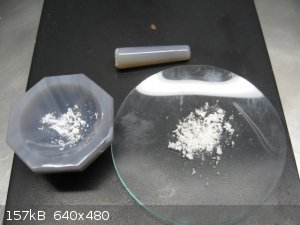
[Edited on 9-11-2016 by Magpie]
The single most important condition for a successful synthesis is good mixing - Nicodem
|
|
|
j_sum1
Administrator
       
Posts: 6219
Registered: 4-10-2014
Location: Unmoved
Member Is Offline
Mood: Organised
|
|
Well done Magpie. This is something of an accomplishment.
I have learned a bit reading this thread over the past couple of days. Great to get some success!
|
|
|
Magpie
lab constructor
    
Posts: 5939
Registered: 1-11-2003
Location: USA
Member Is Offline
Mood: Chemistry: the subtle science.
|
|
Thank you j_sum1. It is a weird synthesis.
The single most important condition for a successful synthesis is good mixing - Nicodem
|
|
|
Magpie
lab constructor
    
Posts: 5939
Registered: 1-11-2003
Location: USA
Member Is Offline
Mood: Chemistry: the subtle science.
|
|
I decided to attempt preparation of succinic acid using the Dakin synthesis referenced above. This prep is indeed much milder than that presented by
Chemplayer. There was no tar formed and there seems to be a considerable amount of unreacted glutamic acid, a white solid insoluble in ether and
mostly insoluble in water.
Ether is used to extract the succinic acid from the aqueous phase products. Succinic acid has solubility of 8.8mg/mL in ether per Wiki. A continuous
"lighter-than-water" extractor is used. Luckily I have one of these bought for another project but never used. The pictures below show it in use for
this preparation. So far the extraction has been running for 4 hours. I plan to run it for another 2 hours.
The little funnel catches the dripping ether and returns it to the bottom of the column via a 6mm tube. From there the ether rises through the
aqueous phase and overflows into the pot. In the pot it is vaporized and then condensed in the Allihn condenser. The succinic acid remains in the
pot.
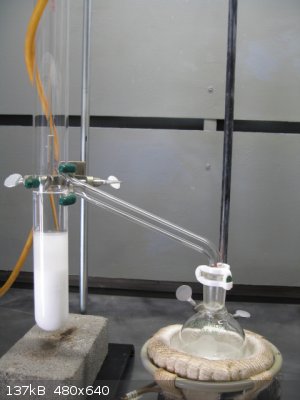 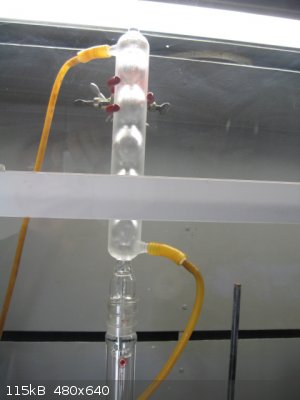 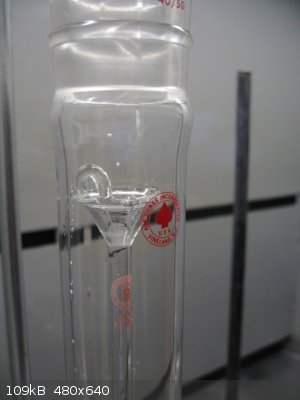
The single most important condition for a successful synthesis is good mixing - Nicodem
|
|
|
Magpie
lab constructor
    
Posts: 5939
Registered: 1-11-2003
Location: USA
Member Is Offline
Mood: Chemistry: the subtle science.
|
|
I finished up my attempt at making succinic acid via the Dakin procedure as described in my previous post. I started this with 12.6g of glutamic acid
made from monosodium glutamate (Accent MSG).
The ether extract described was distilled today to recover the ether as shown in the picture. When there was only a few mLs of boiling liquid left I
poured it into a crystallizing dish. When the visible liquid had evaporated I placed the product in a 103°C drying oven for 2 hours. The picture
below shows the mangy, sticky, paltry product, weighing 0.2g. I made no attempt to purify it.
This sparse on detail 1908 procedure then is a failure, at least in my hands. Admittedly I only ran the extraction for 6 hours. My lab manual
recommends extracting for at least 24 hrs. I don't think that would have improved the quality of the product, however.
In conclusion I think Chemplayer has the right idea by incorporating more aggressive conditions. In his hands it seemed to go well. But he
never did confirm the identity of his product.
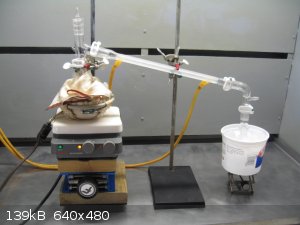 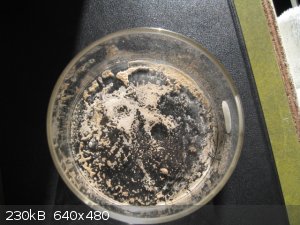
The single most important condition for a successful synthesis is good mixing - Nicodem
|
|
|
chemplayer...
Hazard to Others
  
Posts: 191
Registered: 25-4-2016
Location: Away from the secret island
Member Is Offline
Mood: No Mood
|
|
Thanks Magpie for writing up your findings on this. The ammonium glutamate / H2O2 method does seem to work better but in the end we found it hard to
find a relatively simple qualitative test for succinic acid so we never managed to conclusively confirm the product identity. It's definitely not
starting material though and seems to have the right solubility profile. We may put this on our future 'to do' list if we can find a test, and then
see if we can use succinic acid for something interesting.
|
|
|
Magpie
lab constructor
    
Posts: 5939
Registered: 1-11-2003
Location: USA
Member Is Offline
Mood: Chemistry: the subtle science.
|
|
As noted above I used mp and MW to confirm the identity of the small amount of succinic acid made with your method. Is there any reason why you can't
use these methods?
The single most important condition for a successful synthesis is good mixing - Nicodem
|
|
|
chemplayer...
Hazard to Others
  
Posts: 191
Registered: 25-4-2016
Location: Away from the secret island
Member Is Offline
Mood: No Mood
|
|
We didn't think of doing a melting point but yes, although we don't have a proper apparatus we could try to improvise.
|
|
|
symboom
International Hazard
    
Posts: 1143
Registered: 11-11-2010
Location: Wrongplanet
Member Is Offline
Mood: Doing science while it is still legal since 2010
|
|
What about from cream of tartar potassium bitartrate .Tartaric acid its the structure with two OH groups added
Maybe there is a potassium bitartrate to succinic acid route
It just needs t o more OH groups
|
|
|
CuReUS
National Hazard
   
Posts: 928
Registered: 9-9-2014
Member Is Offline
Mood: No Mood
|
|
why not make succinic acid from MSG using a mixture of H2O2 and HClO2 ? H2O2 reacts with
HClO2 to make HOCl which then reacts with HClO2 to form ClO2 which is again converted to HClO2 by
H2O2,completing the cycle.Simultaneously,MSG first gets converted to CHO-CH2-CH2-COOH(amino acid to
aldehyde reaction by HOCl) and then the CHO is oxidised to COOH by HClO2(pinnick oxidation) to give succinic acid.https://en.wikipedia.org/wiki/Pinnick_oxidation#Side_reactio...
[Edited on 9-12-2016 by CuReUS]
|
|
|
Magpie
lab constructor
    
Posts: 5939
Registered: 1-11-2003
Location: USA
Member Is Offline
Mood: Chemistry: the subtle science.
|
|
Preparation of Succinic Acid using the method of Chemplayer…
Introduction
I found Chemplayer’s YouTube (ref 1) video for making succinic acid (SA). This method seemed attractively simple using a cheap and readily available
precursor, monosodium glutamate (MSG). H2O2 (35%) was also readily available. The ammonium bicarbonate (Baker’s ammonia), was readily obtained by
mail.
Chemplayer’s method is an adaption of the 1908 procedure of HD Dakin (ref 2), as indicated in his video.
Chemplayer’s method first makes glutamic acid from MSG by adding a stoichiometric amount of HCl. 25g of the resulting glutamic acid is then used to
make SA. SA is finally recovered by crystallization.
Procedure
Once the required reagents were on hand I proceeded to follow the Chemplayer procedure.
A small amount of pure white SA resulted from my 1st run. Its identity was confirmed by melting point and titration. I have since made several more
runs using different MSGs in an effort to improve yield and purity.
Listed below are my observations from these several runs. The results of my last synthesis are also reported:
Observations
1. Upon addition of the HCl the formed glutamic acid quickly turned very thick and I could not continue stirring with my Corning PC-320 magnetic
stirrer using a 2” stirbar. The slurry had the consistency of mayonnaise. Perhaps Chemplayer has a much more powerful stirrer than I?
2. I first used Accent MSG from my grocery store but it gave a yellow colored product. Thinking this MSG might have additives, I bought Tradewinds
brand (much cheaper) at a restaurant supply store. However, it also produced a colored product. As a last effort I bought Aji-No-Moto brand MSG from
an Asian grocery store (even cheaper yet at $3/lb) as this is the brand cited by Chemplayer in his video. Still there was no difference in
performance or product color. In review this multi-purchase seems foolish as all the MSGs had the appearance of pure, well formed crystals.
3. The major difference (and problem) was the appearance of color which I now assume is a degradation product. It first appears about ½ way through
the 30 minute addition of 30% H2O2 at 65-80°C. At this point it colors the solution a translucent canary yellow but by the end of the 90 minute
heating period at 80°C the color is a translucent tea brown. I tried to remove this color using an ether extraction. However, the color is highly
soluble in water and none transferred to the ether. Removal of a significant amount of this color was achieved by boiling with activated charcoal.
There was some residual amount that was not removed after 2 tries, however. This is an undesirable contaminant and lowers the melting point of the SA
product.
Pictures taken during this run are as follows:
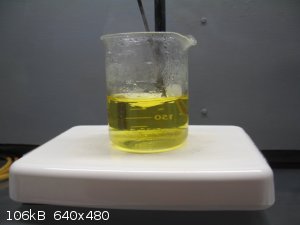
Reactants midway through H2O2 addition
Attachment: phpH769vH (110kB)
This file has been downloaded 830 times
Product after 1.5hr at 80°C
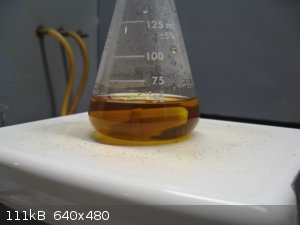
Product after 1st treatment with activated charcoal
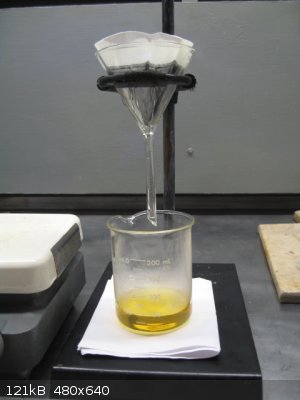
Product after 2nd treatment with activated charcoal
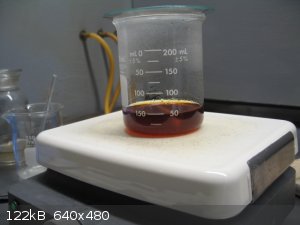
Product after evaporation
4. Chemplayer adds 10mL of 50% sulfuric acid to the final solution. IMO this is not enough as the pH only came down to 4. To get the best
precipitation I have calculated from the pKa of succinic acid using the Henderson-Hasselbalch equation that the pH should be brought down to ≤ 2.2:
pH = pKa + log ([succinate ion]/[SA]) (Henderson-Hasselbalch eqn)
Succinic acid pKa1 = 4.2
For ~100% free acid:
pH = pKa1 + log (1/100) = 4.2 -2.0 = 2.2
But I found that the pH should not be lowered below 2.2 as this can destroy filter paper. A target pH of 2 is also recommended in an article by
researchers separating SA from a fermentation broth (ref 3).
5. I did not get a nice clean precipitate by simply chilling the final solution as did Chemplayer. I first chilled my solution in a freezer overnight
but it froze. After thawing at room temperature I left it for a day in my 10°C lab. Crystallization then occurred as shown below:
Attachment: phpoTncSu (145kB)
This file has been downloaded 785 times
1st crop precipitation
There seemed to be a strong tendency to supersaturate based on the published solubility of SA.
2 crops of crystals were recovered during the last run. These were caught on a 7cm Buchner funnel using no wash water. Washing the crystals with
ice-cold water to remove color caused excessive loss to the filtrate. A picture of the two crops of crystals, dried at room temperature, is shown
below:
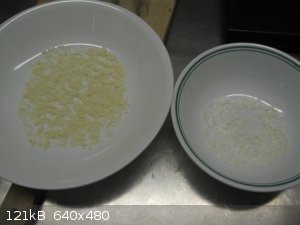
1st (left) and 2nd crops of crystals
Results
The first crop retained some of the yellow of the mother liquor. The 2nd crop, surprisingly, was almost pure white and glistening. An effort is
being made to recover a 3rd crop. After a few days in my cold lab crystals are just starting to form.
Yields (theoretical maximum = 20.0g):
1st crop: 4.6g
2nd crop: 4.4g
The combined yield for the two crops was 9.0g of putative SA. Based on the 25g of glutamic acid charged this is a 45.0 %yield.
Melting points (Wiki value for SA = 184°C):
1st crop was 170°C
2nd crop was >230°C
Titrated MW using 0.1N NaOH (Wiki value 118.09):
1st crop: 162
2nd crop: 583
Discussion and Conclusions
After watching Chemplayer’s video I thought that this would be an easy synthesis. To the contrary, I found that, mostly due to the color,
purification of the crystals was tedious. Additionally, waiting for crystal precipitation, and air drying of the crystals (a cautionary measure),
became quite time-consuming.
My conclusion has to be that I produced very little if any succinic acid. I have put a lot of time and effort into trying to get this synthesis to
work. It’s time for me to “stop beating a dead horse.”
I would really like to hear from Chemplayer concerning the differences in our results. I hope he can tell us why this synthesis seemed to proceed so
much smoother in his hands.
References
1. “Prepare Succinic Acid from Monosodium Glutamate,” by Chemplayer, YouTube, January 16, 2016. https://www.youtube.com/watch?v=kDLSRk068SU
2. ”Succinic Acid by Oxidation of Glutamic Acid,” HD Dakin, J. of Biol. Chemistry, 1908.
3. “One Step Recovery of Succinic Acid from Fermentation Broths,” by Li, Wang, Wu et al, Separation and Purification Technology,
vol 72, issue 3, May 11, 2010, pp. 294-300.
http://www.sciencemadness.org/talk/viewthread.php?tid=62326&...
Your comments, questions, and recommendations are welcomed.
[Edited on 10-12-2016 by Magpie]
[Edited on 10-12-2016 by Magpie]
[Edited on 11-12-2016 by Magpie]
The single most important condition for a successful synthesis is good mixing - Nicodem
|
|
|
| Pages:
1
2
3
4 |